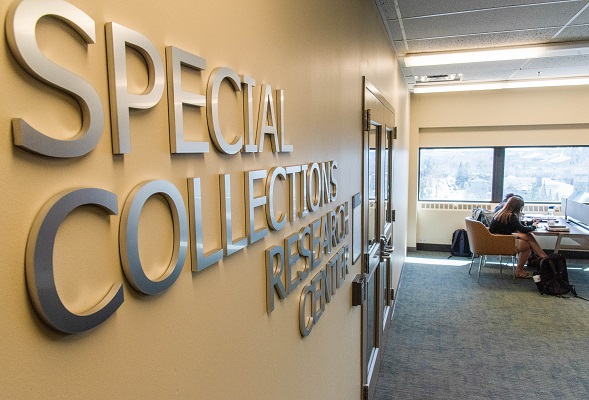Search Results
Correspondence
This series consists of a small amount of correspondence, mainly letters from Esther Dolgoff to Frank Gerould written in 1980, and emails from Gerould and Helms to Labadie curator Julie Herrada in the 2010s providing some context for the manuscript.
Correspondence
The Correspondence series contains 9 linear feet of letters to and from Inglis. A tireless correspondent, she often combined business and personal matters with her associates. The folders are arranged alphabetically within each series, and notes are made if letters are (to) or (from) the individuals listed.
Correspondence
The Correspondence series is comprised of approximately 2.5 linear feet of material, foldered alphabetically by author with individual letters and cards within each folder arranged chronologically. The majority of the correspondence discusses Bockris' professional endeavors, including correspondence between publishers, lawyers, and sources. Additionally included are some personal correspondence such as letters, notes, and cards. Within the series are several notable, lengthy correspondence partners including Isabelle and Jean Louis Baudron, 1984-1997 (5 folders); Gerard Malanga, 1977-1996 (10 folders); Miles, 1977-1998 (7 folders); Elvira Peake, 1984-1999 (5 folders); Claude and Mary Beach Pelieu, 1983-1996 (5 folders); and especially Ingrid von Essen, 1983-2001 (31 folders); Christopher Whent, 1985-2002 (7 folders); and Andrew Wylie, 1974-2000 (41 folders). Correspondence with von Essen is of particular note as she was both a professional collaborator and personal friend of Bockris, and in addition to incoming correspondence, outgoing correspondence from Bockris to von Essen , 1977-2001 (17 folders), is included in the series.
The series also includes correspondence from notable individuals, poets such as Anne Waldman and Allen Ginsberg, John Giorno, Jeff Goldberg, artists and personalities including Lawrence Ferlinghetti, Art Garfunkel, Bobby Grossman, John Waters, Aram Saroyan, and book subjects Bebe Buell, William Burroughs, Debbie Harry, and Terry Southern.
Correspondence
The Correspondence series (2.5 linear feet) is comprised of handwritten and typed letters, greeting cards, postcards, and telegrams and is grouped into three subseries: J. Louis Engdahl's outgoing correspondence; Engdahl Family correspondence, comprised of letters written by his wife, daughter, sister-in-law and brother-in-law, and other relatives in the Engdahl, Levitin, and Rodriguez families; and Others, listed alphabetically by name. Ralph Korngold, Frank Hayes, and Ruth Benedict are among the correspondents. Most of the Engdahl Family correspondence is comprised of Pauline Levitin Engdahl's letters to Louis.
Included in the Others subseries are two folders of "Sympathy Letters," written to Pauline Levitin Engdahl at the time of her husband's death. Notable among these are letters from William L. Patterson, chairman of the International Labor Defense. Some of the letters in these folders also discuss memorial and financial arrangements. Included with the sympathy letters are an undated, unsigned poem, "A Monument to Love," and an empty envelope addressed to Pauline Levitin Engdahl and dated 1927. The association of these items to the rest of the materials in this grouping is unclear.
Engdahl's letters to his wife, especially, and also to his daughter, comprise most of the Correspondence series. They recount in detail Engdahl's daily activities, his hopes and fears, and his affection and longing for his loved ones during his time apart from them (long and frequent periods of separation being an unfortunate consequence of his life's work). In earlier correspondence, dating from the 'teens, Louis and Pauline Engdahl both comment frequently on Victor Berger and his work. Later letters deal primarily with Louis's work for the ILD on behalf of the Scottsboro defendants. One can trace, too, the evolution of J. Louis Engdahl's relationship with Pauline Levitin (Engdahl), from good friends and allies in a common cause, to sweethearts, and finally spouses.
Correspondence
The Correspondence series consists of approximately 0.6 linear feet of material. The vast majority of the correspondence consists of handwritten letters from Danny Kaye to Holly Fine. Although the letters span the years 1934 to 1986, the bulk of the correspondence dates from late 1934 to late 1937. Kaye’s letters are very affectionate and personal. The letters center mostly on the relationship between Kaye and Fine, but Kaye also mentions developments in his career, including the shooting of his first short film in 1937. Most of the correspondence dating from the 1950s is brief and relatively insubstantial. The correspondence series also includes a subseries of letters to Holly Fine from other correspondents, including several from Kaye’s wife, Silvia Fine, Kaye’s brothers Sparky and Larry, and Bea Marcus, and other people involved with the Marcus show. The Larry Kaye correspondence, in which he sometimes addresses his relationship with his brother Danny, his brother’s career, and his brother’s marriage, is the most noteworthy of this subseries.
Correspondence
Correspondence (1909-1973) is the largest series in the collection. It is arranged alphabetically, and includes both incoming and outgoing correspondence. The correspondence from the 1930s and 1940s contains lengthy critical and philosophical exchanges with important American anarchists such as Henry Cohen, Steven Byinton, and Marcus Graham. On more personal matters, Labadie corresponded with Theodore Schroeder and John Scott. The correspondence with Agnes Inglis is interesting for its documentation of the early years of the Labadie Collection at the University of Michigan Graduate Library. Inglis frequently wrote to Labadie informing him about the researchers using the Collection, as well as about new acquisitions. It was through her that Labadie met James J. Martin, who later published a collection of Labadie's essays. Labadie's correspondence with Mildred Loomis spans the longest period of time, from 1947 to 1971. Important correspondence in the 1960s include Herbert Roseman and Don Werkheiser, whom Labadie met through the School of Living.
